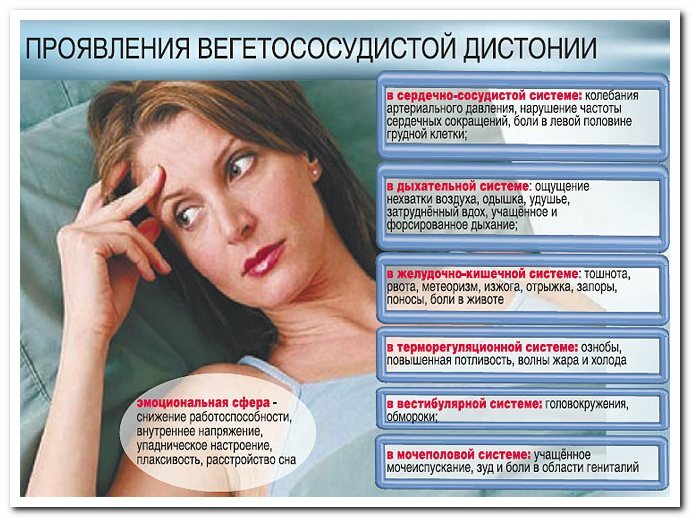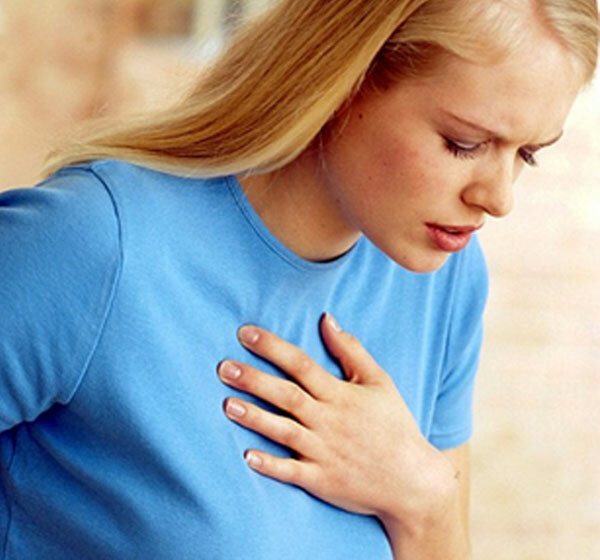Vegeto-vascular dystonia - symptoms, types of VSD and treatment
 The diagnosis of vegetative-vascular dystonia( VDD) is perceived by many as something insignificant - complaints about weakness and dizziness are misleading.And the result is the ignoring of these symptoms and the lack of qualified medical care.Meanwhile, doctors insist - vegetative-vascular dystonia refers to serious disorders in the body's work, it is a malfunction in the work of all body systems.First of all, the vegetative nervous system suffers - it is responsible for the regulation of blood pressure indicators, the work of the airways, the production of hormones, the activity of the genitourinary system, and in general the normal rhythm of a person's life depends on the work of the autonomic nervous system.It is necessary not only to know what vegeto-vascular dystonia is, but also to diagnose it in time, to receive adequate treatment.
The diagnosis of vegetative-vascular dystonia( VDD) is perceived by many as something insignificant - complaints about weakness and dizziness are misleading.And the result is the ignoring of these symptoms and the lack of qualified medical care.Meanwhile, doctors insist - vegetative-vascular dystonia refers to serious disorders in the body's work, it is a malfunction in the work of all body systems.First of all, the vegetative nervous system suffers - it is responsible for the regulation of blood pressure indicators, the work of the airways, the production of hormones, the activity of the genitourinary system, and in general the normal rhythm of a person's life depends on the work of the autonomic nervous system.It is necessary not only to know what vegeto-vascular dystonia is, but also to diagnose it in time, to receive adequate treatment.
Types of
All the characteristic symptoms for vegetative-vascular dystonia are associated, first of all, with pathologicalChanges in blood vessels.It is precisely in what tone they are, and the classification of the disease in question will depend.
VSD - hypertonic type
This type is characterized by high vascular tone, high blood pressure, and patients complain of heart palpitations, hot flashes, headaches and fatigue.
VSD - hypotonic type
In this case, manifestations of vegetative-vascular dystonia will be associated with a low vascular tone - the patients are diagnosed with low blood pressure.Typical for vegetative-vascular dystonia in the hypotonic type is general weakness, darkening in the eyes, fainting, sudden changes in blood pressure, the lower / upper limbs are almost always cold.
VSD - mixed type
Such development of the considered disease is characterized by instability, variability of vascular tone.And the blood pressure readings will not have a clear indication - they then become too high, then suddenly drop to the possible minimum.Doctors say that if a patient is diagnosed with an SVD in a mixed type, then one should be prepared for the appearance of symptoms characteristic of both the hypotonic type of the disease and the hypertonic type.
VSD - cardiac type
This type of considered disease can be diagnosed in patients who complain of severe pain in the heart area.They do not have any definite character, they can be aching and pulsating, often there is a feeling of irregularities in the heartbeat.Moreover, such periodically arising pain sensations in the region of the heart do not worsen the general state of human health, and a full examination excludes the development of heart pathology.
VSD - vagotonic type
Always accompanied by a malfunction in the respiratory system.Against the backdrop of shortness of breath, inability to take a full breath, the patient begins to lower blood pressure.
Causes of development of vegetative-vascular dystonia
The true causes of the appearance of the considered disease have not yet been clarified, but the doctors identify several factors that may well be provocative. These include:
- heredity - vegetative-vascular dystonia in this case will develop in early childhood, but at an older age it remains;
- some physical diseases of a chronic nature - for example, pathology of the endocrine, digestive, cardiovascular systems;
- diseases of the peripheral and / or central nervous system;
- chronic fatigue;
- susceptibility to stress and depression.
 According to statistics, most often vegeto-vascular dystonia develops against a background of neurosis, and the only manifestation may be the symptoms of a cold( classic acute respiratory-viral infection). If we consider the mechanism of development of the disease under consideration against the background of neurosis, then it is possible to keep within several points:
According to statistics, most often vegeto-vascular dystonia develops against a background of neurosis, and the only manifestation may be the symptoms of a cold( classic acute respiratory-viral infection). If we consider the mechanism of development of the disease under consideration against the background of neurosis, then it is possible to keep within several points:
- A person is experiencing a lot of stress, especially dangerous is the condition on the background of psychological exhaustion or overexertion.
- The body( in particular - the brain) is not able to cope with this situation and the psyche simply "hides" the problem.
- But after all, the signal in the brain about the pathology has already arrived, and he begins to exhibit the problem, working specifically on the internal organs - a person can suddenly begin pain syndrome in the stomach or heart and the like.
Doctors say that such stress can be caused by regular stresses, impossibility / inability to express their experiences with words, closedness of a person, deep feelings alone.The state worsens also against the background of the use of alcoholic beverages, tobacco smoking, emotional instability.
Symptoms of vegetative-vascular dystonia
The disease can manifest itself in different ways - several syndromes have been identified and described, which are considered to be signs of vegetative-vascular dystonia.
Hyperventilation syndrome
This syndrome is intense and characterized by rapid breathing, respiratory arrest and air deficiency.Patients will experience a feeling of shortness of breath, inhaling a false spasm of the larynx - a person thinks that he begins to suffocate.And this state necessarily leads to a panic attack - absolutely everyone is afraid of death.In the hyperventilation syndrome, pathological changes occur even in the blood - it loses too much oxygen, which leads to the inhibition of respiratory activity. The result is :
- impaired sensitivity around the mouth and near the nose;
- decreased sensitivity in the feet and hands;
- muscle spasms without specific localization;
- dizziness.
Sweating disorders
In vegetative-vascular dystonia, the majority of patients( up to 89%) complain of increased sweating.This syndrome manifests during attacks - palms sweat, droplets of sweat protrude on the forehead and throughout the face, during periods of absence of seizures the process of sweating is not violated.
Cardiovascular syndrome( cardiovascular)
This syndrome manifests itself in different ways in the disease under consideration - it can be intense and weak.But in any case, patients will complain of heart rhythm disturbances( rapid or slow heartbeat), sudden changes in blood pressure.Often in cardiovascular syndrome there are chilliness of bones and feet, pronounced pallor of the skin( "marbling"), hot flashes( they mimic menopause in women). In some cases, vegetative-vascular dystonia is manifested by a cardial syndrome - for it will be the characters:
- pains in the heart region of a different nature - aching, harsh, throbbing;
- a discomforting sensation in the anatomy of the heart - they are difficult to describe by the patient.
 Please note: has such symptoms for angina pectoris, but it is easy to differentiate two such different diseases - the cardiac syndrome occurs with angina only after physical exertion, and when nitroglycerin is taken, everything passes for several minutes.With vegetative-vascular dystonia, the same syndrome also occurs in absolute calm, and nitroglycerin does not give the expected effect.
Please note: has such symptoms for angina pectoris, but it is easy to differentiate two such different diseases - the cardiac syndrome occurs with angina only after physical exertion, and when nitroglycerin is taken, everything passes for several minutes.With vegetative-vascular dystonia, the same syndrome also occurs in absolute calm, and nitroglycerin does not give the expected effect.
Cystalgia
It is manifested by rapid urination.And, this condition patients do not associate with the use of too much fluid, and doctors do not reveal any violations in the work of the kidneys and urinary system.
Irritable bowel syndrome
Vegeto-vascular dystonia may also be felt by the pain syndrome in the abdomen( aching, spasmodic discomfort), and a violation of the stool, and a false urge to defecate.But in some patients against the background of the progression of the disease in question there may be several other signs of a digestive system disorder. These include:
- a violation of appetite - can either completely disappear interest in food, or, conversely, begin to overeating;
- nausea and vomiting that occur immediately after eating;
- swallowing is broken - the patient is hard to make even a sip of water;
- is a non-intensive pain in the epigastric region or "under the spoon".
Note: in such manifestations of vegetative-vascular dystonia, the patient should be excluded from somatic diseases of the gastrointestinal tract - for example, peptic ulcer of the stomach / duodenum. 
Thermoregulation disorder This is an unstable body temperature - the patient experiences chilliness periodically, it is cold even in a warm room.Some patients, on the contrary, notice spontaneous temperature increase - this condition is transferred well, characteristic weakness / drowsiness / headaches for respiratory-viral or inflammatory diseases are absent.Note: sometimes physicians fix different body temperatures in the left and right armpits.This condition is more common in the development of vegetative-vascular dystonia in childhood.
Sexually transmitted disorders
Men have a violation of potency, women complain of lack of orgasms and a decrease in sexual activity.But against this background, the sexual attraction to the opposite sex does not disappear anywhere.In general, all the listed symptoms, characteristic for vegetative-vascular dystonia, can not be manifested simultaneously and with any kind of disease.To be aware of what VVD type correspond to specific symptoms, be sure to check with the table:
| Type VSD | Characteristic symptoms |
| VSD on hypertonic type | marked nausea and vomiting, Regardless of food intake.Decreased appetite, down to total loss of interest in food.Periodically occurring headaches of a non-intensive nature.Sweating is increased, in the period of acute exacerbations palms are very sweating.There is a sense of fear that does not lend itself to logical explanation.Periodically, "flies" appear before your eyes. |
| VSD for cardiac type | Rapid heart rate.Periodically appearing pain in the heart of a variable nature.Arrhythmia.Slow heartbeat.Increased sweating. |
| VSD for hypotonic type | Lowering of blood pressure.General weakness.Pale skin.Disturbance of respiratory activity - patients can not make a full breath.Nausea and / or heartburn.Stool disorders are diarrhea or constipation. |
| VSD for mixed type | Arrhythmia, tachycardia.Attack of fear of near death due to problems in the heartbeat.Disturbance of respiratory activity - the patient does not have enough air.Pain syndrome with localization in the heart.Pre-mental states - sudden dizziness, darkening in the eyes.Increased sweating of the lower / upper extremities. |
| VSD for vagotonic type | Palpitation of the heart is slow.Salivation is increased.Disturbances in the work of the gastrointestinal tract.Lowering blood pressure.Breathing is difficult. |
Panic Attack at VSD
 This is another syndrome that will be a characteristic symptom of the manifestation of vegetative-vascular dystonia.A person experiences severe fear, a sense of approaching anxiety, a wave of fear covers him.In this case, the body sends out signals about the danger, but it does not provide solutions to the problem.Therefore, the patient experiences the strongest fear of death, it seems to him - the heart stops, breath intercepts.It is noteworthy that literally in 10-15 minutes a panic attack against the background of the VSD passes, the person's condition is normalized.
This is another syndrome that will be a characteristic symptom of the manifestation of vegetative-vascular dystonia.A person experiences severe fear, a sense of approaching anxiety, a wave of fear covers him.In this case, the body sends out signals about the danger, but it does not provide solutions to the problem.Therefore, the patient experiences the strongest fear of death, it seems to him - the heart stops, breath intercepts.It is noteworthy that literally in 10-15 minutes a panic attack against the background of the VSD passes, the person's condition is normalized.
Diagnosis of vegetative-vascular dystonia
 When a person seeks medical help for complaining about the above conditions, the specialist should exclude any somatic disease - this is done first.This means that the patient has to undergo a complete examination of the body - from a laboratory study of blood / urine / feces to computed tomography.The next step is to visit a psychoneurologist.Only such a narrow specialist can work qualitatively with the patient and identify the reasons that triggered the development of the condition in question.And in this case, do not be shy, ashamed and ignore the visit to the psychoneurologist.Firstly, it is by no means a psychiatrist and he does not treat exclusively mental patients.And secondly, without clarifying the reasons for this condition, it will not be possible to conduct adequate, effective therapy.
When a person seeks medical help for complaining about the above conditions, the specialist should exclude any somatic disease - this is done first.This means that the patient has to undergo a complete examination of the body - from a laboratory study of blood / urine / feces to computed tomography.The next step is to visit a psychoneurologist.Only such a narrow specialist can work qualitatively with the patient and identify the reasons that triggered the development of the condition in question.And in this case, do not be shy, ashamed and ignore the visit to the psychoneurologist.Firstly, it is by no means a psychiatrist and he does not treat exclusively mental patients.And secondly, without clarifying the reasons for this condition, it will not be possible to conduct adequate, effective therapy.
Treatment of vegetative-vascular dystonia
There is no specific, medical treatment of the disease under consideration - everything is selected exclusively on an individual basis.Psychoneurologists will help to understand the patient with their internal problems, adjust the body's response to the release of adrenaline or insulin, inadequate behavior of all organs and systems. But in addition, the following recommendations will be given:
-
 Learn how to work on any of the relaxation techniques - for example, do yoga.
Learn how to work on any of the relaxation techniques - for example, do yoga. - Mastering the respiratory gymnastics - this will help quickly put in order the nervous system at the initial stage of the development of an attack of vegetative-vascular dystonia.
- Competently to allocate time of rest and work - it is not necessary to refuse a banal day off for the sake of career or financial well-being.
- Do not "lock yourself in" - you need to constantly keep in touch with someone: it can be relatives, friends, colleagues at work.
- Eliminate alcohol from life - remember that it gives an imaginary feeling of relief, but in fact only increases the number of problems.
- Refuse cigarettes / cigarettes - for some patients this is more difficult than giving up alcoholic beverages.In this case, you can use all the modern methods - nicotine patches, special aerosols, tablets and chewing gums.
- Carry out hardening procedures - it will be enough to use a contrast shower to stimulate / train the entire body.
 Note: in especially severe cases, a doctor can prescribe some medications to stabilize the condition - these can be antidepressants, sedatives.But such appointments should be made only by a specialist on the basis of a patient's examination, confirmation of the diagnosis - one can not use even the simplest medications alone, for example, valerian.
Note: in especially severe cases, a doctor can prescribe some medications to stabilize the condition - these can be antidepressants, sedatives.But such appointments should be made only by a specialist on the basis of a patient's examination, confirmation of the diagnosis - one can not use even the simplest medications alone, for example, valerian.
Features of treatment of vegetative-vascular dystonia
This disease is treated for a very long time - you need to be prepared for the fact that it will take years to attend physiotherapy procedures, maintain an absolutely healthy lifestyle, and periodically take medication.But you can not say that this rule is suitable for absolutely all patients with vegetative-vascular dystonia - someone after a few sessions at the psychoneurologist comes back to normal, and someone is forced to constantly fight with the manifestations of the disease. If you decided to use funds from the category of traditional medicine to normalize your condition, then listen to the recommendations of the doctors:
-
 you will definitely get permission to use this or that remedy from the treating specialist;
you will definitely get permission to use this or that remedy from the treating specialist; - do not forget to exclude allergies to herbs, flowers and fruits - it is from medicinal plants that various broths are prepared with soothing effect;
- if vegetative-vascular dystonia is diagnosed in childhood, then use in the treatment of folk remedies is strictly prohibited;
- in some cases will need to eliminate cardiovascular diseases - for example, healers recommend using a bath with mustard powder to relieve the attacks of the disease in question.If the patient has an anamnesis of the pathology of the heart or blood vessels, then this can lead to hypertensive crisis, tearing off the thrombus.
Vegeto-vascular dystonia should not be perceived as easy fatigue - it is a serious disruption in the work of the departments of the nervous system, which can lead to very sad consequences.For more information on the symptoms, treatment and prevention of vegetative-vascular dystonia, you will receive this video review:
Tsygankova Yana Aleksandrovna, medical reviewer, therapeutist of the highest qualification category.



